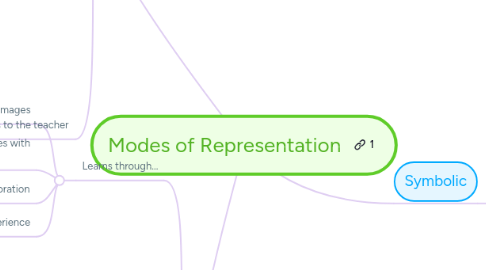
1. Enactive
1.1. Learns through...
1.1.1. Observation
1.1.2. Repetition
1.1.3. Imitation
1.2. Interacts with music by...
1.2.1. Listening and responding to teacher
1.2.2. Listening and and responding to peers
1.3. Engages in music through...
1.3.1. Performing by
1.3.1.1. Singing
1.3.1.2. Playing
1.3.1.3. Using body and environmental sounds
1.3.2. Describing by
1.3.2.1. Moving
1.3.3. Creating by
1.3.3.1. Improvising
1.4. Acquires musical concepts by...
1.4.1. Listen and respond to music in a way that relates to the topic
1.4.2. Show understanding by
1.4.2.1. Playing
1.4.2.2. Singing
1.4.2.3. Moving
1.4.2.4. Appropriate non-verbal actions
1.5. Looks to the teacher
1.5.1. model behavior/action
1.5.2. Always accompany instructions with appropriate gestures
1.5.3. Ask questions that can be answered non-verbally
1.5.4. Provide terms without expecting students to use them independantly
1.5.5. Recognize some learning remains at an inactive level
2. Iconic
2.1. Learns through...
2.1.1. Internalization of aural images
2.1.2. association of visual images with musical sound
2.1.3. experimentation and exploration
2.1.4. Generalization from past experience
2.2. Interacts with music by...
2.2.1. Hearing music and matching it with a visual representation
2.2.2. hearing music and devising own representation
2.2.3. seeing music represented iconically and turning it into musical sound
2.3. Engages in music through...
2.3.1. Performing Music
2.3.1.1. Learned by following visuals
2.3.2. Describing music
2.3.2.1. associating music heard with appropriate visuals
2.3.2.2. offering ones own verbal and visual images
2.3.3. creating music
2.3.3.1. improvising in response to verbal, visual, or mental imagery
2.3.3.2. composing music and writing it down with icons
2.4. Acquires musical concepts by...
2.4.1. associating musical examples with a mental image
2.5. Looks to the teacher
2.5.1. visual imagry
2.5.2. a guide rather than a model
3. Symbolic
3.1. Learns through...
3.1.1. associating music with images
3.1.2. Using cognitive skills
3.2. Interacts with music by...
3.2.1. listening and association with musical notation
3.2.2. seeing music notation and turning it into sound
3.3. Engages in music through...
3.3.1. performing music
3.3.2. using music to describe music notation
3.4. Acquires musical concepts by...
3.4.1. using music to relate to personal images
3.4.2. responding to music with musical or verbal signals
3.5. Looks to the teacher
3.5.1. moving further with musical ability when ready
3.5.2. correcting labeling music
3.5.3. use traditional music terms
